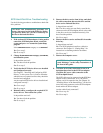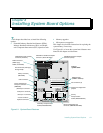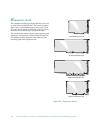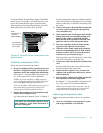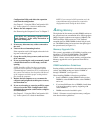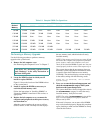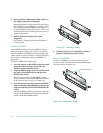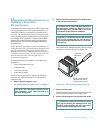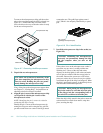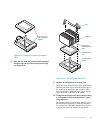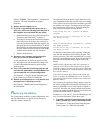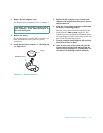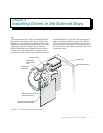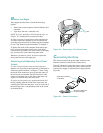
Installing System Board Options 8-7
U
pgrading the Microprocessor or
Installing a Secondary
Microprocessor
In addition to the zero insertion force (ZIF) socket for the
primary microprocessor on the system board, there is a
second ZIF socket to accommodate a secondary micro-
processor. The secondary microprocessor must have the
same operating frequency as the primary microprocessor.
For example, if the system has a 180 megahertz (MHz)
Pentium Pro primary microprocessor, your secondary
microprocessor must also be a 180-MHz Pentium Pro
microprocessor.
NOTE: If you are upgrading a system by installing a sec-
ondary microprocessor, you must order a microprocessor
upgrade kit from Dell. The upgrade kit from Dell con-
tains the correct version of the microprocessor for use as
a secondary microprocessor. Not all versions of the Pen-
tium Pro microprocessor will work properly as a
secondary microprocessor.
The following items are included in a microprocessor
upgrade kit:
•
The new microprocessor chip
•
A new heat sink
•
A new heat sink clip
•
A new snap-in badge
Use the following procedure to remove the old micro-
processor and install the upgrade or to add a second
microprocessor.
1. Remove the left computer cover.
See “Removing the Computer Covers” in Chapter 7.
2. Remove the metal clip that secures the heat sink
to the microprocessor socket.
Press down on the folded part of the clip with a small
screwdriver to release the clip (see Figure 8-6).
Figure 8-6. Microprocessor Securing Clip
3. Remove the heat sink.
The thermal interface pad is bonded to the heat sink
and will remain attached to the old heat sink.
4. Remove the microprocessor chip from the socket.
CAUTION: See “Protecting Against Electro-
static Discharge” in the safety instructions at
the front of this guide.
CAUTION: Never remove the heat sink from a
microprocessor unless you intend to remove
the microprocessor. The heat sink is necessary
to maintain proper thermal conditions.
WARNING: The microprocessor chip and heat
sink can get extremely hot. Be sure the micro-
processor has had sufficient time to cool before
you touch it.
CAUTION: Be careful not to bend any of the
pins when removing the microprocessor chip
from its socket. Bending the pins can perma-
nently damage the microprocessor chip.
press here to
release clip
microprocessor securing
clip hooks over tabs on
front and back of socket



